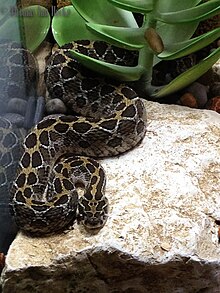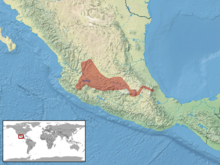| Crotalus polystictus | |
|---|---|

| |
|
Scientific classification
| |
| Domain: | Eukaryota |
| Kingdom: | Animalia |
| Phylum: | Chordata |
| Class: | Reptilia |
| Order: | Squamata |
| Suborder: | Serpentes |
| Family: | Viperidae |
| Genus: | Crotalus |
| Species: | C. polystictus
|
| Binomial name | |
| Crotalus polystictus (
Cope, 1865)
| |

| |
| Synonyms | |
| |
The Mexican lance-headed rattlesnake [3] or lance-headed rattlesnake [4] (Crotalus polystictus) is a venomous pit viper species found in central Mexico. No subspecies is currently recognized. [5]
Description
Adults usually grow to a total length of 60 to 70 cm (24 to 28 in), although exceptionally large specimens may be as much as 100 cm (39 in) long. [3]
Geographic range
The species is found on the plateau of central Mexico from southern Zacatecas and northeastern Colima east to east-central Veracruz. It occurs at elevations between 1,450 and 2,600 m (4,760 and 8,530 ft). The type locality given is "Table Land, Mexico", although a restriction to "Tupátaro, Guanajuanto, Mexico" was proposed by H.M. Smith and Taylor (1950). [2]
Conservation status
This species is classified as Least Concern on the IUCN Red List of Threatened Species (v3.1, 2001). [1] Species are listed as such due to their wide distribution, presumed large population, or because they are unlikely to be declining fast enough to qualify for listing in a more threatened category. The population trend was down when assessed in 2007. [6]
References
- ^ a b Mendoza-Quijano, F.; Quintero Díaz, G. (2007). "Crotalus polystictus". IUCN Red List of Threatened Species. 2007: e.T64327A12769761. doi: 10.2305/IUCN.UK.2007.RLTS.T64327A12769761.en. Retrieved 13 November 2021.
- ^ a b McDiarmid RW, Campbell JA, Touré T. 1999. Snake Species of the World: A Taxonomic and Geographic Reference, vol. 1. Herpetologists' League. 511 pp. ISBN 1-893777-00-6 (series). ISBN 1-893777-01-4 (volume).
- ^ a b Campbell JA, Lamar WW. 2004. The Venomous Reptiles of the Western Hemisphere. Comstock Publishing Associates, Ithaca and London. 870 pp. 1500 plates. ISBN 0-8014-4141-2.
- ^ Mehrtens JM. 1987. Living Snakes of the World in Color. New York: Sterling Publishers. 480 pp. ISBN 0-8069-6460-X.
- ^ "Crotalus polystictus". Integrated Taxonomic Information System. Retrieved 1 August 2007.
- ^ 2001 Categories & Criteria (version 3.1) at the IUCN Red List. Accessed 13 September 2007.
Further reading
- Cope, E.D. 1865. Third contribution to the HERPETOLOGY of Tropical America. Proc. Acad. Nat. Sci. Philadelphia 17: 185-198. (Caudisona polysticta, pp. 191–192.)
- Smith, H.M. and E.H. Taylor. 1950. Type localities of Mexican reptiles and amphibians. Univ. Kansas Sci. Bull. 33: 313-380.
External links
- Crotalus polystictus at the Reptarium.cz Reptile Database. Accessed 12 December 2007.
- Mexican Lance-headed Rattlesnake at the Saint Louis Zoo. Accessed 18 June 2008.
